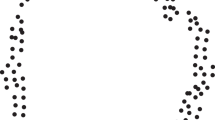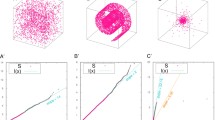Abstract
The study compares the extent to which naturally structured data and artificial, relatively random data (both with the same basic parameters) produce simple structure factors which are uniquely determined. Two examples of unstructured matrices were compared with the ball problem matrix. The results show that an oblique position of maximum hyperplane count in the structured data differs from that in the unstructured by reaching a significantly more unique position in terms of the exactitude with which it is re-discoverable when starting from different positions, and by reaching (at the maximum) a significantly higher hyperplane count.
Similar content being viewed by others
References
Bargmann, V. R. Signifikanzuntersuchugen der einfachen Strukture in der Factoranalyse.Mitteilungsblatt für Mathematische Statistik, Physiea-Verlag, Wursburg, 1954.
Burt, C. The factorial study of temperamental traits.Brit. J. Psychol, Statist. Sec., 1948,1, 178–203.
Cattell, R. B. A note of factor invariance and the identification of factors,Brit. J. Psychol., Statist. Sec., 1949,2, 134–139.
Cattell, R. B. Extracting the correct number of factors in factor analysis.Educ. psychol. Measmt, 1958,18, 791–838.
Cattell, R. B. The basis of recognition and interpretation of factors.Educ. psychol. Measmt, 1962,22, 667–697.
Cattell, R. B. and Baggaley, A. R. The salient variable similarity index for factor matching.Brit. J. statist. Psychol., 1960,8, 33–46.
Cattell, R. B. and Cattell, A. K. S. Factor rotation for proportional profiles: analytical solution and an example.Brit. J. statist. Psychol., 1955,8, 83–91.
Cattell, R. B. and Dickman, K. A dynamic model of physical influences demonstrating the necessity of oblique simple structure.Psychol. Bull., 1962,59, 389–400.
Cattell, R. B. and Foster, M. The rotoplot program for multiple single-plane, visually-guided rotation (up to 36 factors).Educ. psychol. Measmt, 1963, in press.
Cattell, R. B. and Muerle, J. L. The “maxplane” program for factor rotation to oblique simple structure.Educ. psychol. Measmt, 1960,20, 569–590.
Cattell, R. B. and Sullivan, W. The scientific nature of factors: a demonstration by cups of coffee.Behav. Sci., 1962,7, 184–193.
Cattell, R. B. and White, O. Confactor rotation discussed and illustrated. Advanced Publication No. 17, Lab. of Personality Assessment, Univ. of Illinois, 1962.
Guttman, L. Some necessary conditions for common-factor analysis.Psychometrika, 1954,19, 149–161.
Harman, H. H.Modern factor analysis. Chicago: Univ. Chicago Press, 1960.
Hurley, J. L. and Cattell, R. B. The Procrustes program, producing direct rotation to test an hypothesized factor structure.Behav. Sci., 1962,7, 258–262.
Kaiser, H. F. The varimax criterion for analytic rotation in factor analysis.Psychometrika, 1958,23, 187–200.
Kaiser, H. F. Relating factors between studies based upon different individuals. Preliminary unpublished manuscript, 1960.
Landhal, H. D. Centroid orthogonal transformation.Psychometrika, 1940,5, 67–74.
Neuhaus, J. O. and Wrigley, C. The quartimax method.Brit. J. statist. Psychol., 1954,7, 81–91.
Pinzka, C. and Saunders, D. R. Analytic rotation to simple structure II. Princeton, N. J.: Educational Testing Service Research Bulletin, RB-54-31, 1954.
Saunders, D. R. The rationale for an “oblimax” method of transformation in factor analysis.Psychometrika, 1961,26, 317–324.
Saunders, D. R. Factor analysis I. Some effects of chance.Psychometrika, 1948,13, 251–257.
Siegal, S.Nonparametric statistics for the behavioral sciences. New York: McGraw-Hill, 1956.
Sokol, R. R. A comparison of five tests for completeness of factor extraction.Transaction of the Kansas Acad. of Sci., 1959,62, 141–152.
Thurstone, L. L. Primary mental abilities.Psychometric Monogr., No. 1. Chicago: Univ. Chicago Press, 1938.
Thurstone, L. L.Multiple-factor analysis. Chicago: Univ. Chicago Press, 1947.
Tucker, L. R. A method for synthesis of factor analysis studies. Personnel Research Section Report, No. 984, Washington, D. C.: Dept. of the Army, 1951.
Wrigley, C. and Neuhaus, J. O. The matching of two sets of factors. Contract Memorandum Report, A-32, Urbana, Ill.: Univ. of Illinois, 1955.
Author information
Authors and Affiliations
Rights and permissions
About this article
Cite this article
Cattell, R.B., Gorsuch, R.L. The uniqueness and significance of simple structure demonstrated by contrasting organic “natural structure” and “random structure” data. Psychometrika 28, 55–67 (1963). https://doi.org/10.1007/BF02289548
Received:
Revised:
Issue Date:
DOI: https://doi.org/10.1007/BF02289548




